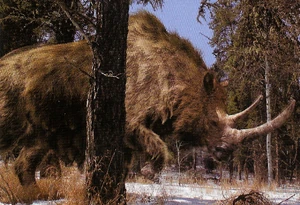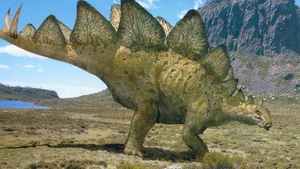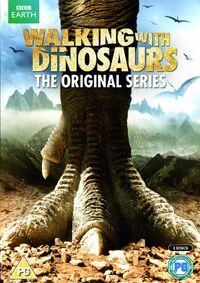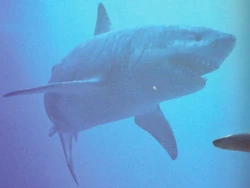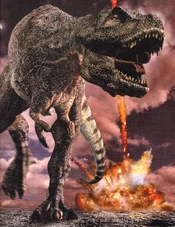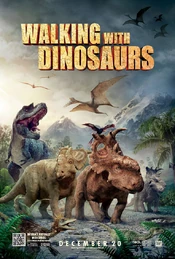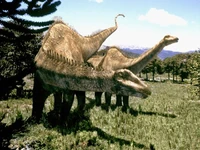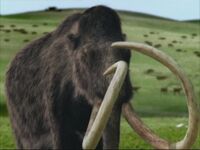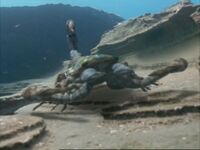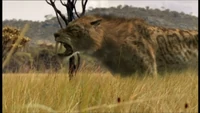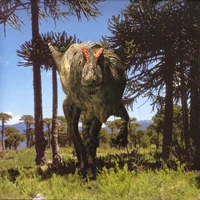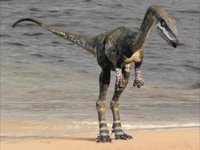This page contains an archive of the articles of the month that have appeared on the Walking With Wikis home page.
Undated
These articles were featured before the current system was put in place.
June 2014
The Woolly Rhinoceros was an Ice Age rhinoceros from the Pleistocene. It was a rhino fully adapted to the hostile conditions of the late Pleistocene.
The Woolly Rhinoceros was a large rhinoceros. It looked similar to a modern rhinoceros from the African savanna. However, unlike modern rhinos, it possessed a thick coat of brown fur several centimetres long.
The Woolly Rhinoceros had two large horns on its head. These horns were made of keratin.
The Woolly Rhinoceros was a type of rhino which lived during the Ice Age. Due to the extremely cold climate it lived in, this animal adapted to cope with its environment. One of its various adaptations was its thick, shaggy coat. This coat of fur were several centimeters thick and helped to keep it warm in the winter. It would shed its fur in the spring and summer months in favor of a shorter, cooler coat.
Woolly Rhinoceroses had significantly larger horns than its modern, African cousins. They most likely used their horns to dig up plants than had been buried by the snow. It was also used as a weapon against predators and rivals. The eyesight of the Woolly Rhinoceros was very poor. Its sense of smell and hearing on the other hand was excellent and would have alerted it to any danger. If it identified something as a threat, it would charge instantly at its target.
May 2014
Stegosaurus is a genus of stegosaurid dinosaur that lived during the late Jurassic period in what is now North America.
A large, heavily built, herbivorous quadruped, Stegosaurus had a distinctive and unusual posture, with a heavily rounded back, short forelimbs, head held low to the ground and a stiffened tail held high in the air. Its array of plates and spikes has been the subject of much speculation. The spikes were most likely used for defense, while the plates have also been proposed as a defensive mechanism, as well as having display and thermoregulatory functions.
Stegosaurus had a relatively low brain-to-body mass ratio: its' brain was only the size of five walnuts, but it didn't have a true second brain in the back, but only an accumulation of nerve ganglia that helped Stegosaurus move its' hind quarters. Stegosaurus also had a short neck and small head, meaning it most likely ate low-lying bushes and shrubs. It was the largest of all the stegosaurians (bigger than genera such as Kentrosaurus, Tuojiangosaurus, Dacentrurus, Weurhosaurus, and Huayangosaurus) and, although roughly bus-sized, it nonetheless shared many anatomical features (including the tail spines and plates) with the other stegosaurian genera.
April 2014
Walking With Dinosaurs is a six-part dinosaur television documentary mini-series that was produced by the BBC, narrated by Kenneth Branagh, and first aired in the United Kingdom in 1999. The series was subsequently aired in the United States on the Discovery Channel with the Branagh's narration replaced with that of Avery Brooks. The series uses computer-generated imagery and animatronics to recreate the reign of the dinosaurs, beginning in the late Triassic period and concluding in the late Cretaceous period at the K-T boundary mass extinction event, 66 million years ago.
The Guinness Book of World Records reported that Walking With Dinosaurs was the most expensive documentary series per minute ever made.
Imagine you could witness a prehistoric sunset - imagine you are watching insectivorous pterosaurs chase moths in the moist evening air and bull Triceratops lock horns over a young female. This is no longer a dream.
Walking With Dinosaurs makes that distant world as real and natural as images from today's Serengeti. Tracing the 160 million-year history of dinosaurs, from their first appearances to their abrupt demise, this series marks a watershed in television imagery.
Classic natural history techniques, leading edge computer technology and animatronics combined with the latest scientific findings, recreate the sights and sounds of an endlessly fascinating era. Walking With Dinosaurs brings to life the mystery and excitement of the age when these reptiles roamed our planet.
March 2014
Megalodon were giant prehistoric sharks featured in Sea Monsters.
Superficially, Megalodon resembled modern great white sharks, but with the overall body length of 17-23 meters, they had jaws with a 2 to 3-metre-wide opening span, studded with teeth that are quite different from the modern white sharks, up to 5-8.5 inches in length, and could swallow them whole. Weighing up to 93 tons, Megalodon was the largest shark of all time and the biggest carnivorous fish ever to roam the seas, weighing as much as the Argentinosaurus!
Being so big, Megalodon hunted practically everything that lived in the late Cenozoic oceans - dolphins, primitive whales, manatees, etc. The second and third episodes of Sea Monsters has examined this feature in length, examining the hunting techniques of a juvenile Megalodon hunting an artificial Odobenocetops and then an adult Megalodon hunting a larger prehistoric whale as well.
February 2014
Tyrannosaurus rex (or T. rex for short) was a large predatory theropod coelurosaurian dinosaur that lived in the Late Cretaceous period and lived up until the extinction of the non-avian dinosaurs. It's featured in several of Impossible Pictures' prehistory-based documentaries, such as Walking With Dinosaurs. It is the most famous and popular of all the dinosaurs, known for it's cultural impact, even more than Apatosaurus (formerly known as Brontosaurus). It is also called the King of the Dinosaurs. T. rex is among the largest land predators ever. The theropods Giganotosaurus and Spinosaurus may be bigger, but this is not known for any real certainty.
January 2014
Walking With Dinosaurs is a new dinosaur film produced by BBC Earth named after the well-recieved 1999 TV documentary miniseries. It was released on December 20, 2013. Unlike the TV series, the dinosaurs featured in the film were voiced by actors and were fully computer animated with no animatronics. However, the sets filmed live action. The goal is to make audiences feel like they've gone back in time.
Set in North America in the late Cretaceous period, the film follows the lives of three Pachyrhinosaurus named Patchi, Scowler and Juniper from infancy to adulthood. Their story is related by Alex the Alexornis who has a symbolic relationship with the trio. Their enemy is a Gorgosaurus named Gorgon, a fearless hunter.
(Read more...)
December 2013
Liopleurodon was a pliosaur and perhaps the mightiest aquatic predator of all time. Its long body would have cruised silently through the shallow seas of the late Jurassic, propelled by its flapping flippers. Its size is a topic of considerable debate; the largest pliosaur specimens are not attributed to the Liopleurodon genus and are 18 m long. The longest confirmed Liopleurodon fossils are estimated to have grown up to 15 m (although some fossils still show that they could have grown to 25 m and weighed 150 tonnes).
A massive sea predator with four flippers, they are the biggest, carnivorous reptiles ever. They are awe-inspiring sea monsters. Liopleurodon was a hunter. Its long jaws and rows of needle-sharp teeth would have made marine crocodiles, the giant fish Leedsichthys, ichthyosaurs and even other pliosaurs vulnerable to attack.
November 2013
Diplodocus was a 30 meter long, 15-25 ton sauropod dinosaur from the late Jurassic time period (155 - 145 MYA) that lived on the territory of the modern Western United States. Other potential Diplodocus speciemens, as Seismosaurus, were 15 meters longer and weighed nearly 7 times as much, making Diplodocus perhaps the biggest dinosaur on Earth.
Diplodocus was one of, if not, the longest sauropod animals ever to live. Seismosaurus, a synonym of Diplodocus, was 39-53.9 meters long (45 meters on average) and possibly over 100 tonnes in weight making it the longest animal that has ever existed and possibly the largest land animal. In fact, it was so large that even a pack of allosaurs wasn't able to hunt fully grown specimens (though they would attack individuals which are weak, sick, old, injured and young). They lived in huge herds, sometimes up to 100 dinosaurs, led by a matriarch, as the modern elephants do.
October 2013
The Woolly mammoth (known for being one of the most, if not, the most the most famous, popular, and endangered mammalian animal of the Pleistocene) was a prehistoric relative of modern-day elephants, just as its cousin, the Columbian mammoth, was. It is undoubtedly one of the most popular animals of the Pleistocene. Woolly mammoths also lived in huge herds.
Woolly mammoths had a number of adaptations to the cold, most famously the thick layer of shaggy hair, up to 1 meter in length with a fine under wool, for which the woolly mammoth is named. The coats probably moulted in summer to cool off, otherwise it will overheat and die. They also had far smaller ears than modern elephants; the largest mammoth ear found so far was only 30 cm (12 in) long, compared to 180 cm (71 in) for an African elephant. Other characteristic features included a high, peaked head that appears knob-like in many cave paintings and a high shoulder hump resulting from long spines on the neck vertebrae that probably carried fat deposits.
September 2013
Brontoscorpio was the largest scorpion ancestor ever lived during the Silurian period. It had a large stinger about the size of a lightbulb and the stinger itself can deliver a powerful venom that paralyzed prey. Brontoscorpio also had 2 pairs of pincers with the larger pincers used for grasping prey and the smaller pincers used for tearing apart prey. Brontoscorpio hunted small marine animals like Cephalaspis and trilobites. Brontoscorpio adapted strong jaws for crushing and tearing apart the tough armored body of its prey.
August 2013
Smilodon was the biggest and most powerful sabre-toothed cat of all times, and defiantly the most famous prehistoric cat. It lived in North and South America at 2.5 million to 100,000 years ago. Originaly from North America, Smilodon came to South America 2 million years ago and replaced the native hunters, Phorusrhacos, as top predators. Smilodon was over 100 to 500 kg depending on the species.
August 2010
Allosaurus (Different Lizard) is the top predator of the Jurassic period. The largest specimens grew to 13 meters (43 feet) long, making it one of the biggest Jurassic predator on the landscape, almost as big as Tyrannosaurus Rex of the later Cretaceous period, but with a more lightweight build and a relatively weaker bite (even then a lion), designed to rip flesh rather than to crush bone. An individual named Big Al was just a sub-adult when it died, yet it had 19 injuries and signs of various diseases. Allosaurus had distinctive crests in front of his eyes for display. They were probably pack hunters and used their numbers to catch larger animals such as Apatosaurus and Diplodocus. Proof of this was shown in the Cleveland Lloyd-Quarry with 75% of the bones belonged to Allosaurus. Though, not everyone agrees and think that like modern reptiles, it showed aggression to each other.
Febuary 2009
Coelophysis is a 3-meter long theropod dinosaur from the Norian stage of the late Triassic period.
It lived in North America during the Late Triassic period (around 230 MYA). It was also among the first of the dinosaurs ever to appear on Earth.
Coelophysis and other early dinosaurs were light boned, fast, and they are beautifully adapted for killing. But what made them unique are special hips and ankles that allowed them to stand perfectly balanced on two hind legs. They also could make noise without using much precious water. With lightning fast reactions, they were built to survive. This was unlike other sauropsids at the time, and a unique trait of the averesmentalians.

